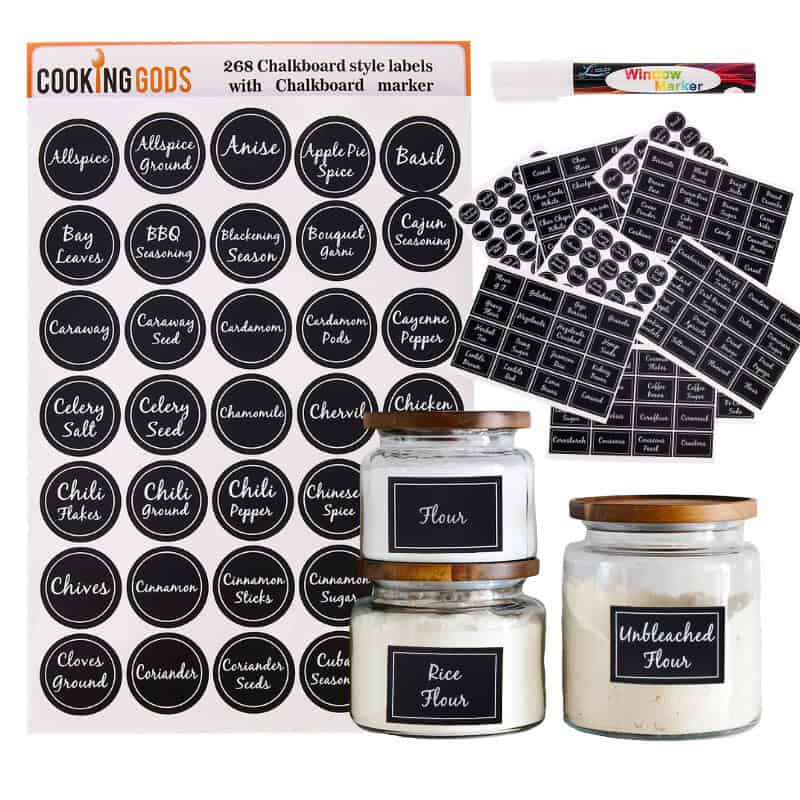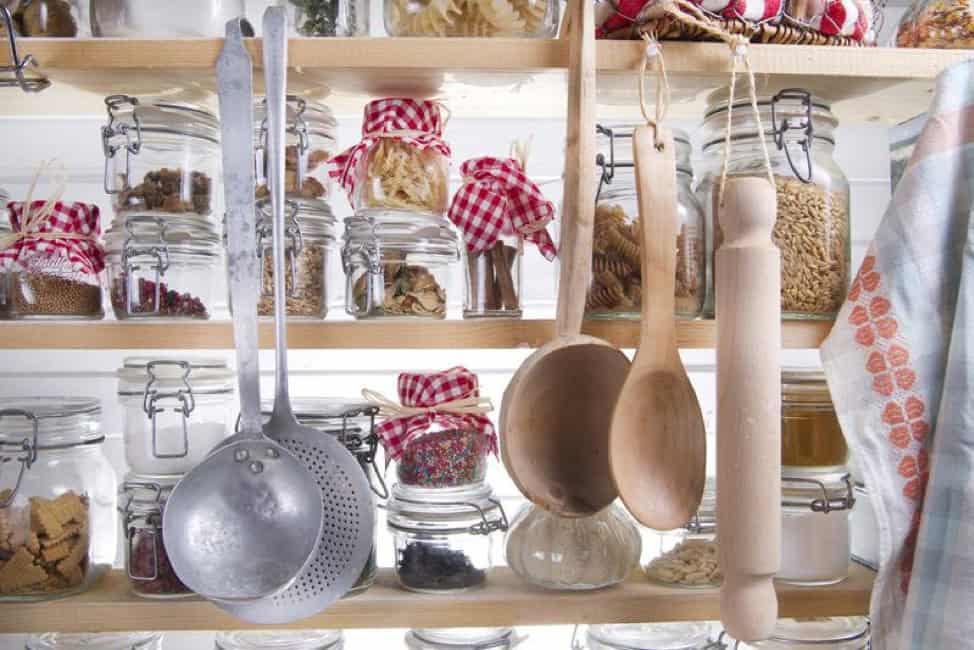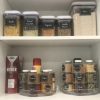Here’s a quick quiz for you: Have you tried to organize your pantry, only to discover that you have six containers of cinnamon but no boxes of cereal for breakfast tomorrow? You probably have. Most people have. The key to making sure that you don’t have too much of one item and not enough of another is to organize your pantry. Here are three tips to teach you how to do just that.

Label Spaces In Your Pantry
The folks at your local library could teach you a little something about shelf organization. If it has been a while since you’ve been to the library, here’s a reminder. On each of the shelves, there is usually a little sign that tells what types of books you’ll find on the shelf in question. You can organize your pantry in the same way.
Have certain shelves or areas dedicated to certain items.
By labeling your shelves, you can see in a quick second which items go where.
You’ll get even more mileage out of this system if you also organize the pantry by categories. For example, dedicate one section of your pantry to bulk dry goods, like pasta or rice, one for snacks, one for canned goods, etc. Once you have the sections established, label them.
If you have a lot of smaller items in a section – Consider using baskets in that area.
Baskets are prefect for items like snack foods or spices, or keeping a particular food category together eg all your pasta varieties.
An important tip – Remember to label your baskets .
First In, First Out
First in, first out or FIFO counts as a staple in the restaurant world. The principle speaks to how these retail outlets make sure that the first item that goes in their pantries or fridges is the first thing that goes out. This cuts down on spoilage. Restaurant workers ensure this happens by rotating stock. The new stock gets pushed to the back and the older stock gets pushed back up to the front. This principle doesn’t only work in industrial kitchens. It’ll work in yours, too. Put a system in place, like setting a rule for how little of a product should be remaining before adding it to the shopping list can be a helpful way of making sure that you never run out. That might mean you have enough of something to make one or two more meals before you add the item to your shopping list. The idea is that the better you keep tabs on your rotation, the better chance you have at eating all your food before it goes bad.
Use the Right Storage Containers
The containers you use can make all the difference when you organize your pantry. If you can’t see what you have on the shelves, then chances are you have food waste. Instead of going with opaque containers, opt for clear plastic containers to store dry goods, like macaroni, rice, and flour. This setup allows you to see at a glance what dry goods you’re running out of. Mason jars or glass jars, make excellent transparent food containers. Buy more when the container is low enough to accommodate what’s left plus a bag or two of fresh stock.
Make sure your jars and containers are like your shelves or baskets : Clearly labelled!






Organizing your pantry
Organizing your pantry helps you to keep better track of your food. It ensures that you buy food exactly when you need it. You know your pantry-organizing efforts have been successful when you buy just enough food to keep it stocked, which cuts down on food waste considerably.
If you would like to get some more pantry organization ideas, I have written several blog posts on this topic
For a full pantry organization overhaul – Read our Pantry Organization blog post and get the free checklists and work sheets.
For a quick pantry organization makeover This Blog post has 8 quick ideas to buy on Amazon and no tools required!!




I can definitely relate to the experience of having an overabundance of spices while missing key staples in my pantry! It’s always a reminder that organization can truly impact our daily routines. I love the idea of labeling spaces in the pantry; it not only makes things easier to find but can also help in keeping track of what you have and what you might need to restock.
It’s interesting how our cooking habits often tell a story about our pantry selections, isn’t it? An overabundance of spices can feel like stepping into a world of culinary possibilities, yet when you can’t find the basic staples, it creates a bit of a culinary conundrum. I think you touched on something really important with organization. It can shift our experience in the kitchen dramatically.
I get what you’re saying about having a ton of spices but missing the essentials. It’s funny how we focus on all the exotic flavors and forget the basics that hold everything together. A well-stocked pantry is such a balancing act, isn’t it?
“I’m glad you can relate! If you’re looking for some helpful tools to streamline your pantry organization even further, check out this resource.”
https://cookinggods.com/DigestiveHealth
You’ve hit the nail on the head about that balancing act we all face with our pantry. It’s easy to get swept up in the excitement of experimenting with new spices and flavors, but the foundations—the essentials—really are what ground our cooking. Those basic ingredients can elevate even the simplest dishes, giving them depth and richness that’s hard to replicate with just the flashy stuff.
It’s funny how our kitchens often turn into a treasure trove of spices while key essentials go missing. I think it’s really interesting how that reflects our cooking habits, too. Sometimes, we get super excited about trying new recipes or cuisines and end up stocking things like saffron or sumac, while the basics like flour or sugar sit low on our list of priorities.
I love that perspective! It’s so true how our excitement for exploring cuisines leads us to stock up on those gourmet spices. It highlights a fun aspect of cooking—it’s like we’re all mini chefs experimenting with the world’s flavors right in our kitchens.
I really appreciate that you highlighted the excitement of exploring cuisines. It’s true—the kitchen can become this little treasure trove of flavors, and those gourmet spices definitely add a sense of adventure to cooking. I often find myself browsing through local markets or specialty stores, searching for that unique ingredient that will transform a dish.
I totally get what you mean about the thrill of exploring new flavors. There’s something special about wandering through markets or specialty stores, isn’t there? It’s like a mini-adventure every time. I love the way you described the kitchen as a treasure trove of flavors. It truly can feel that way when you stumble upon a spice or ingredient you’ve never used before. It’s like finding a secret weapon that can elevate even the simplest dish.
“I’m so glad to hear that! If you’re looking to elevate your culinary adventures even further, check out this link for some exciting gourmet spices that can truly transform your dishes.”
https://cookinggods.com/ChocolateHealth
It’s so true how easy it is to end up with a kitchen full of exotic spices yet find yourself out of essentials like rice or flour. I think a lot of us have experienced that puzzling moment when we’re craving a simple dish but realize we’re missing the basic building blocks. It’s funny how our excitement for cooking can sometimes lead to a spice collection that resembles a small library while our pantry essentials are bare.
You hit the nail on the head with that observation. There’s something almost ironic about having a pantry stocked with spices from every corner of the globe while basic staples linger in the background, gathering dust. It’s a scenario many home cooks find themselves in—there’s a thrill in experimenting with new flavors and ethnic cuisines, but it sometimes leads us to overlook those everyday essentials that make our cooking more practical.
I can totally relate to that feeling of having spices galore but running out of essential items. It definitely highlights how organization plays a key role in our cooking experience. I’ve found that when my pantry is neatly arranged, not only does it make cooking less chaotic, but it also inspires me to try new recipes since I can actually see what I have on hand.
I totally get what you mean about the spice chaos—if you’re looking to streamline your cooking routine, I found this guide on meal kit subscriptions really helpful for making the most of what you have on hand.
‘Meal Kit Subscriptions: A Smart Guide to Savvy Use’
https://cookinggods.com/meal-kit-subscriptions-a-smart-guide-to-savvy-use/.
Organizing a pantry can truly feel like a journey of discovery. Your quiz hit home for me—I’ve experienced that moment of surprise when I realize I’ve overstocked one item while running low on essentials. It’s almost comical, but it highlights how easy it is to lose track of what we have on hand.
Organizing a pantry can truly feel like a journey of discovery. It’s interesting how those moments of surprise can unfold, isn’t it? Realizing you’ve got ten cans of chickpeas while your favorite pasta is nowhere to be found can feel a bit like a scavenger hunt gone wrong. It’s so easy to lose track when we don’t have a good system in place.
“Absolutely! It’s amazing how our pantries can become little treasure chests. If you’re looking for tips to better manage your stock and avoid those comical moments, check out these handy resources!”
https://cookinggods.com/KetoBreads
It really is a journey of discovery when you dive into your pantry, isn’t it? I can’t tell you how many times I’ve unearthed forgotten items, and it can feel like a mini-adventure each time. Those misplaced pasta cravings really do lead to unexpected finds, like a veritable chickpea mountain. It all highlights how much our eating habits can shift over time.
Your experience is one many of us can relate to, and it’s fascinating how pantry organization can lead us to moments of unexpected humor. It’s all too easy to lose track of what we have stored away—like that time I was digging through my own pantry and came across an avalanche of beans tucked in the back, while my spice rack was practically bare.
Organizing a pantry is a task I’ve wrestled with many times. I can relate to that discovery of an abundance of cinnamon—it’s almost comical how certain items accumulate while staples like pasta or rice seem to vanish. Labeling shelves is a solid suggestion, but I wonder about the effectiveness of aesthetics versus functionality. For instance, if I color-code or label based on expiration dates, it could streamline the process even further.
I hear you loud and clear about the pantry battle. It’s like a never-ending game of hide and seek, with the cinnamon always winning! That spice seems to multiply when you’re not looking, while the pasta mysteriously disappears. One moment you have a whole drawer dedicated to Italian meals, and the next, it’s a desolate wasteland.
I can totally relate to the pantry conundrum you’ve described! I remember a time when I was excited to whip up some oatmeal for breakfast, only to find that I had an abundance of spices—cinnamon being the top contender—but nothing to actually put it on. It’s funny how these little oversights can really throw a wrench in our breakfast plans.
I get that completely! It’s like you prep for a grand breakfast feat and then—plot twist—you’re in a spice-land without the main dish. Who knew being a master chef could feel like navigating an ingredient graveyard? I guess those spices get all fired up, thinking they’ll finally shine, only to end up as the supporting cast in an empty kitchen drama.
Organizing a pantry can feel like a lost cause sometimes, can’t it? I had a similar situation last month where I found seven jars of tomato sauce but no pasta in sight! 🎃 Your idea of labeling is genius; it reminds me of how grocery stores organize their aisles. They have a method to their madness, and it keeps us from wandering aimlessly. I’ve recently started categorizing not just by type, but also by usage—like ‘baking’, ‘snacks’, and ‘quick meals’. It helped me realize what I actually use and what’s just taking up space. Do you think adding a “use by” date label might help too? It could keep us from letting spices (like those six cinnamon containers) gather dust! What do others think?
It sounds like you had quite the pantry adventure with those seven jars of tomato sauce! It’s amazing how ingredients can multiply without us even realizing it. Your approach of categorizing by usage is brilliant—it’s such a practical way to find what you need without getting lost in the shelves. Having set categories like ‘baking’, ‘snacks’, and ‘quick meals’ not only streamlines cooking but also opens your eyes to what you really reach for.
It’s funny how pantries can turn into mini treasure chests of forgotten items sometimes. Seven jars of tomato sauce is quite the find—it’s like you stumbled upon a hidden stockpile. I relate to that feeling of opening a cabinet and not quite knowing what’s in there, only to find old friends like those jars of sauce or even older friends, like that long-forgotten spice blend that seems to have traveled through time.
Organizing a pantry really can feel like a massive challenge! I can relate to the surprise of finding multiple jars of tomato sauce while the pasta is nowhere to be found. It’s funny how we stock up on certain things and overlook the essentials. Your approach to categorizing by usage is brilliant—making it easy to grab what you need based on what you’re cooking sounds so practical. It’s amazing how changing our perspective on organization can unlock a whole different level of efficiency in our kitchens.
I can totally relate to that cinnamon conundrum! It’s funny how we end up with a pantry full of spices and half-empty boxes of essentials. Labeling shelves seems like such a simple yet effective solution. I’ve started to tackle my own pantry organization lately, and it’s amazing how grouping items by category not only clarifies what I have but also inspires me to try new recipes. Speaking of recipes, I’ve begun labeling my spice jars too—it’s like having a mini spice library!
The cinnamon conundrum is a real struggle for many home cooks, isn’t it? It’s surprising how those half-empty boxes can accumulate in our pantries, creating a kind of spice graveyard. It sounds like you’re taking some great steps to bring order to yours. Organizing by category not only makes finding things easier but can really spark creativity in the kitchen. When everything has its place, it opens up possibilities for experimentation.